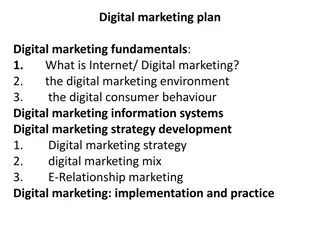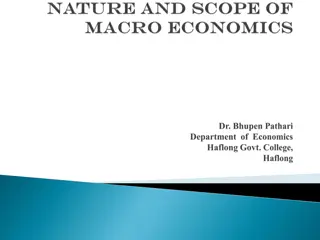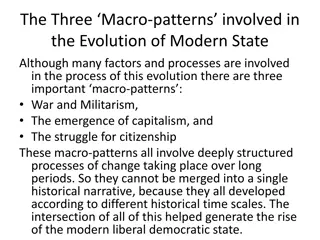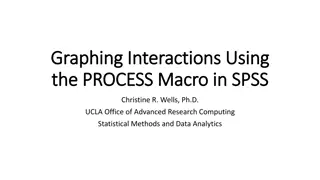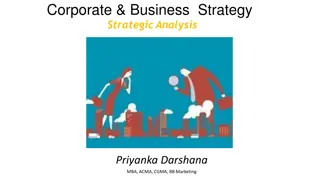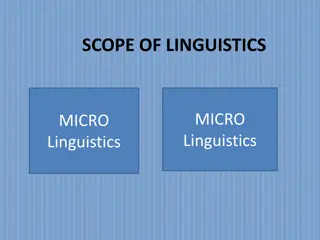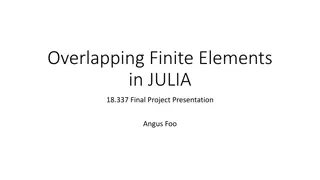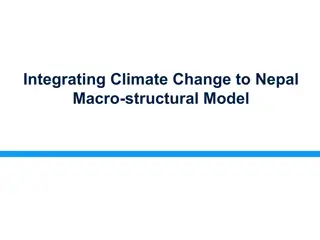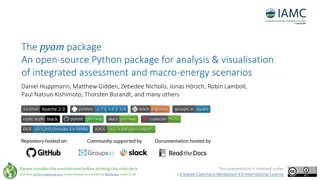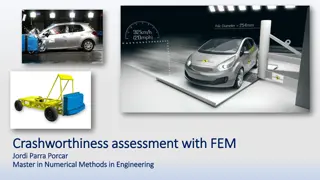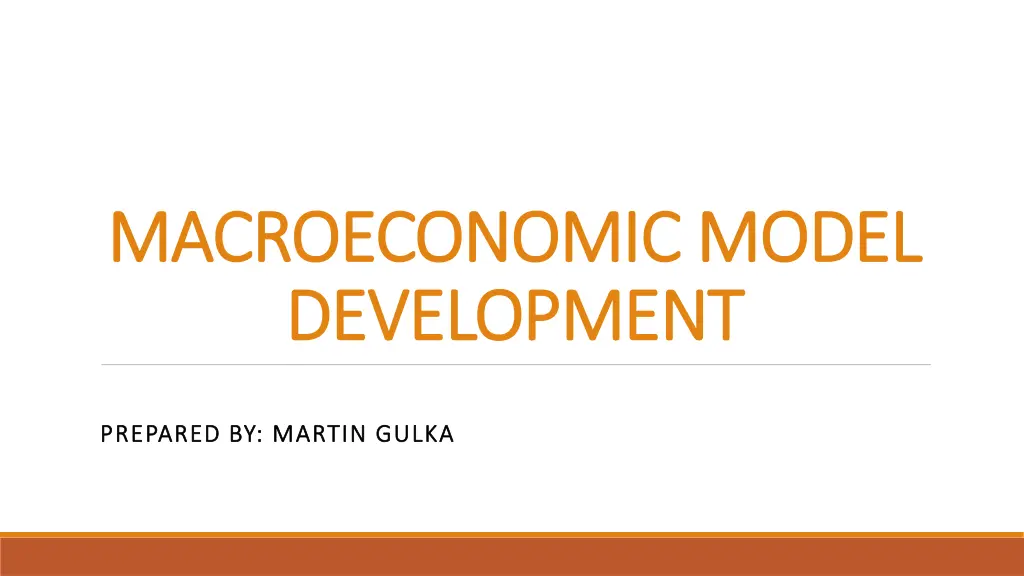
Macroeconomic Model Development for Default Rate Prediction
Dive into the process of developing a predictive macroeconomic model to estimate future default rates, analyzing macroeconomic factors affecting Slovak economy, and incorporating forward-looking elements for provisions calculation and stress testing in banking scenarios.
Download Presentation

Please find below an Image/Link to download the presentation.
The content on the website is provided AS IS for your information and personal use only. It may not be sold, licensed, or shared on other websites without obtaining consent from the author. If you encounter any issues during the download, it is possible that the publisher has removed the file from their server.
You are allowed to download the files provided on this website for personal or commercial use, subject to the condition that they are used lawfully. All files are the property of their respective owners.
The content on the website is provided AS IS for your information and personal use only. It may not be sold, licensed, or shared on other websites without obtaining consent from the author.
E N D
Presentation Transcript
MACROECONOMIC MODEL MACROECONOMIC MODEL DEVELOPMENT DEVELOPMENT PREPARED BY: MARTIN GULKA PREPARED BY: MARTIN GULKA
TASK TASK Our goal is to develop a predictive model ( Macroeconomic model ) based on the macroeconomic factors for estimating future default rates
MODEL PRINCIPLE MODEL PRINCIPLE Once the model is estimated, it can predict default rates based on macroeconomic factors The predictions of the model depends on another predictive model (i.e., predictions of macroeconomic factors) Predictions of the macroeconomic factors for three different scenarios (worst, baseline, best) are delivered by third party* *e.g., Oxford Economics
MODEL USE MODEL USE Provisions calculation the bank should include a forward-looking element into the calculation of provisions Stress testing the bank is required to stress risk parameters to calculate capital requirement impacts under different scenarios of economic development
MODEL DEVELOPMENT PROCESS MODEL DEVELOPMENT PROCESS 1. Data preparation 2. Preliminary data analyses Data quality controls Variables transformation Stationarity analysis Creation of lagged variables 3. Univariate analysis 4. Multivariate analysis (correlation analysis and looking for the best model) 5. Model tests (Multicollinearity, Heteroskedasticity, Autocorrelation, Normality tests) 6. Predictions calculation
DEPENDENT AND INDEPENDENT VARIABLES DEPENDENT AND INDEPENDENT VARIABLES Dependent variable observed default rates for retail segment (not real values due to data anonymization) Independent variables macroeconomic factors related to Slovak economy (real values obtained from publicly available data sources)
MACROECONOMIC MACROECONOMIC FACTORS FACTORS
DEPENDENT VARIABLE DEPENDENT VARIABLE What is default rate (DR) and how it is calculated? Is it needed to do something with our dependent variable?
MODEL SPECIFICATION MODEL SPECIFICATION How to define a correct relation between DR a macroeconomic factors? Macroeconomic factors as of ADT are joined to default rate observed between ADT-1Y and ADT (i.e., all quantities are from the same time span) To explain the relationship, the linear regression is used: Disclaimer: This is not the only possible solution. There are a plenty of other methods (more sophisticated) that could be used instead.
DATA QUALITY CONTROLS + TRANSFORMATIONS DATA QUALITY CONTROLS + TRANSFORMATIONS Since the range of data is not extensive, the data quality controls are quite simple Wherever possible, the (natural) logarithmic transformation is generally recommended*: The log transformation cannot be applied to the variables expressed as growth rates The transformation of the variables should take into account what could be their future behavior (e.g., interest rates can be negative and log transformation could not be appropriate) * The advantages are removing non-linearity, log differences are approximations of the percentual differences, scale independence, ...
STATIONARITY OF TIME SERIES STATIONARITY OF TIME SERIES Is the model specification DR = b1*Unemployment_rate correct? Both time series are non-stationary is this a spurious regression? Stationarity in the model s variables (both dependent and independent) is a necessary condition for least squares to produce consistent estimators The Dickey-Fuller test is used to test null hypothesis that a time series process has a unit root *Unit root process is also referred to as the random walk process. * In case of non-stationarity, we perform a first-difference transformation
UNIVARIATE ANALYSIS UNIVARIATE ANALYSIS Before the Univariate analysis, we have to: create lagged variables (max. 4 lags) identify variables impacted by COVID-19 (misalignment between macro factor and DR) The relationship between macroeconomic factors impacted by COVID-19 (GDP, Unemployment rate, Industrial production) and default rate is performed only until December 2019
UNIVARIATE ANALYSIS UNIVARIATE ANALYSIS VARIABLES REMOVAL Expected sign: the sign of the univariate regression coefficient should be consistent with prior expectations based on economic theory. The variables, whose correlation with the dependent variable does not match expectations, is disregarded from further model development; VARIABLES REMOVAL Statistical significance: univariate regression coefficient should be statistically significant. A threshold of 15% is employed and all variables whose coefficient is not statistically significant are disregarded from further model development; Missing rate: variables with missing rate exceeding a predetermined threshold should be disregarded from further model development. A threshold is set at 10%; Informativeness: variables, for which univariate regression delivers higher R2 should be preferred. A threshold of 5% is employed as a predetermined informativeness level.
ADDITIONAL REDUCTION OF DIMENSION ADDITIONAL REDUCTION OF DIMENSION Even after automatic removals performed during Univariate analysis, we still possess a high number of potentially explanatory variables Choosing the strongest variable from its lagged alternatives could additionally reduce the variables dimension. The correlation matrix can help us further reduce the number of variables:
HOW TO FIND THE BEST MODEL? HOW TO FIND THE BEST MODEL? 1. Stepwise selection not sure how to deal with covid dummies 2. Manual selection/expert-based decisions 3. To run all possible variables combinations This is the most accurate way, however technically the most difficult The number of possible combinations is express as 2^k (e.g., 10 variables leads to 1024 estimated models)
TESTING OF ASSUMPTIONS OF CLRM* TESTING OF ASSUMPTIONS OF CLRM* 1. Multicollinearity no relationships among the explanatory variables Variance inflation Factor (VIF) 2. Homoskedasticity all disturbance terms have the same variance for all t Breusch-Pagan test White s test 3. Serial independence (Autocorrelation) all disturbance terms are not correlated with one another Durbin-Watson test Breusch-Godfrey test 4. Normality of residuals the disturbance are assumed to be normally distributed Shapiro-Wilk test Kolmogorov-Smirnov test * Classical Linear Regression Model (CLRM)
PREDICTIONS OF THE MODEL FOR THREE PREDICTIONS OF THE MODEL FOR THREE SCENARIOS (BASELINE, WORST, BEST) SCENARIOS (BASELINE, WORST, BEST) BASELINE SCENARIO ? DATE 31.3.2023 30.6.2023 30.9.2023 31.12.2023 31.3.2024 30.6.2024 30.9.2024 31.12.2024 31.3.2025 30.6.2025 30.9.2025 31.12.2025 GDP_const 0.83% 1.51% 2.09% 2.54% 2.88% 3.10% 3.21% 3.20% 3.07% 2.83% 2.47% 1.99% BANK_LOANS_CORP_R 9.64% 9.98% 10.28% 10.54% 10.76% 10.94% 11.08% 11.18% 11.24% 11.25% 11.23% 11.16% BANK_DEPOSIT_CORP_R 4.24% 4.41% 4.56% 4.67% 4.74% 4.79% 4.80% 4.78% 4.73% 4.65% 4.53% 4.39% ln = 0.731040 ???????+ 0.706677 ???????? 0.146012 ????_???????_????_?1 0.436622 ????_?????_????_?_?1 1 ? WORST SCENARIO DATE 31.3.2023 30.6.2023 30.9.2023 31.12.2023 31.3.2024 30.6.2024 30.9.2024 31.12.2024 31.3.2025 30.6.2025 30.9.2025 31.12.2025 GDP_const 0.45% 0.48% 0.48% 0.43% 0.34% 0.21% 0.04% -0.18% -0.44% -0.73% -1.08% -1.46% BANK_LOANS_CORP_R 7.85% 6.28% 4.91% 3.76% 2.84% 2.15% 1.67% 1.42% 1.39% 1.59% 2.00% 2.64% BANK_DEPOSIT_CORP_R 1.08% 1.36% 1.62% 1.86% 2.09% 2.30% 2.50% 2.67% 2.83% 2.97% 3.10% 3.20% BEST SCENARIO DATE 31.3.2023 30.6.2023 30.9.2023 31.12.2023 31.3.2024 30.6.2024 30.9.2024 31.12.2024 31.3.2025 30.6.2025 30.9.2025 31.12.2025 GDP_const 3.85% 3.77% 3.73% 3.73% 3.76% 3.83% 3.93% 4.08% 4.25% 4.46% 4.71% 5.00% BANK_LOANS_CORP_R 13.92% 14.73% 15.40% 15.93% 16.30% 16.53% 16.61% 16.55% 16.34% 15.99% 15.49% 14.84% BANK_DEPOSIT_CORP_R 5.66% 5.87% 6.11% 6.39% 6.69% 7.03% 7.39% 7.79% 8.22% 8.68% 9.17% 9.70%

